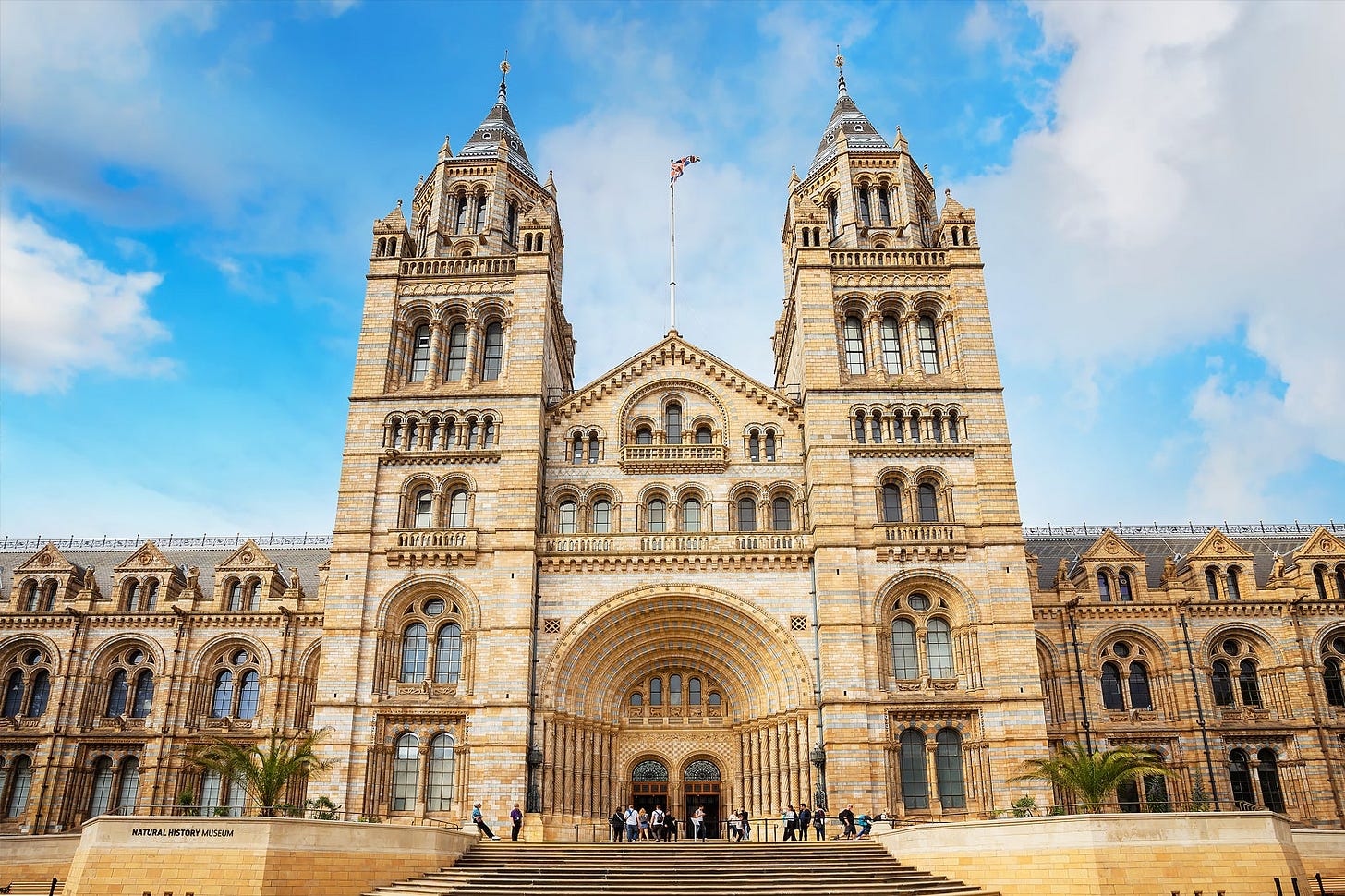Museum Going
Notes from Nature's Cathedral
If you want to take the temperature of a religion, a good place to start is with its sacred sites.
You could diagnose a fair bit about the Church of England from two recent cathedral related news stories. First, Canterbury became the latest cathedral to host a silent disco—a fairly naked attempt to get anybody through its undarkened doorways, in any way, at any time of day. Second, Salisbury Cathedral was unveiled afresh, scaffold free for the first time in 38 years. A glorious sight without; within, however, its Dean is among the many Anglican clergy who have welcomed the church’s unorthodox slide toward formally embracing homsexuality, and urged it to go even further.
I visited a different cathedral this week—“a cathedral to nature,” as it is often called: the Natural History Museum. The magnificent Romanesque design intentionally echoes that of a church building: the dramatic arches of the doorway, the abundant carved figures, the ornate vaulted ceiling of Hintze Hall as one enters. Inside, people are drawn in for an experience intended both to awe the spirit and inform the mind in the same way that a Sunday church service would do.
It would be easy for conservative Christians to assume that the building, completed in 1880, is an intentional thumbing of the nose at the Almighty, coming as it did at the height of the Victorian era, when the air thickened with the stink of the death of God. Instead of biblical scenes, the stained glass windows are stark and plain, devoid of narrative. Instead of carved saints, you find pterosaurs, hyenas, iguanas, capuchins, lungfish; outside, these statues serve as gargoyles. Curiously there are still classic, unspecified demonic gargoyles alongside them—though what evil spirits they are imagining banished from the inner sanctum, I am not sure.
History, however, is not quite so conspiratorial as one might imagine. The architect, Alfred Waterhouse, was raised a Quaker, and designed numerous churches before designing the museum. In 1877, during the museum’s construction, he converted to the Church of England, and had his children baptised into it. His wife Elizabeth was reportedly quite devout, publishing books of prayers, homilies, and religious poetry. And so there is no aggressive secular agenda woven, Da Vinci Code style, into the brickwork of the Natural History Museum.
And yet a little digging suggests that the Waterhouses were fairly unorthodox. Quaker theology is notoriously variable, and they were generally enthusiastic adopters of evolution in the nineteenth century, as well as other liberalising doctrines. Looking at one of Elizabeth’s poetry anthologies, A Little Book of Life and Death, one finds an eclectic mix of verse which adds up to vaguely Protestant inflected humanist spirituality rather than orthodox Christianity—Richard Baxter mixed in with translations of the Bhagavad Gita. Alfred, on his way into Anglicanism, was heavily influenced by F.D. Maurice, an Anglican clergyman and famed “Christian Socialist”. Maurice was once sacked by King’s College for denying the eternity of hell, and dismissed by John Henry Newman as “hazy.”
And so, if we wanted to piece together the outlook of the Natural History Museum’s architect, it was neither the aggressive scientism that was hoping to build a brave new world in some quarters of Victorian England, nor was it the robust Christian orthodoxy which had conceived of the cathedrals of old. It was probably a fudge between the two—and in such a fudge the former will always, eventually, consume the latter.
And that is indeed what has happened. The museum used to be part of the British Museum, and was formally until the 1960s. When it moved into its current building in 1880s, leaving the antiquities and humanities behind in Bloomsbury, it was said that the move was “to separate the works of God from the works of man”. Yet God gets no look in these days. We all know what it means to call it a “cathedral to nature”: God isn’t here any more.
As I made my way round the museum this week though, it felt evident to me that it is not a cathedral to nature in only the general sense of being devoted to its display and aping ecclesiastical architecture in the process. Rather, the very experience of moving through the building is cathedralesque—sometimes as an echo, and sometimes as an inversion.
Keep reading with a 7-day free trial
Subscribe to The New Albion to keep reading this post and get 7 days of free access to the full post archives.




